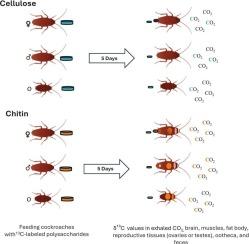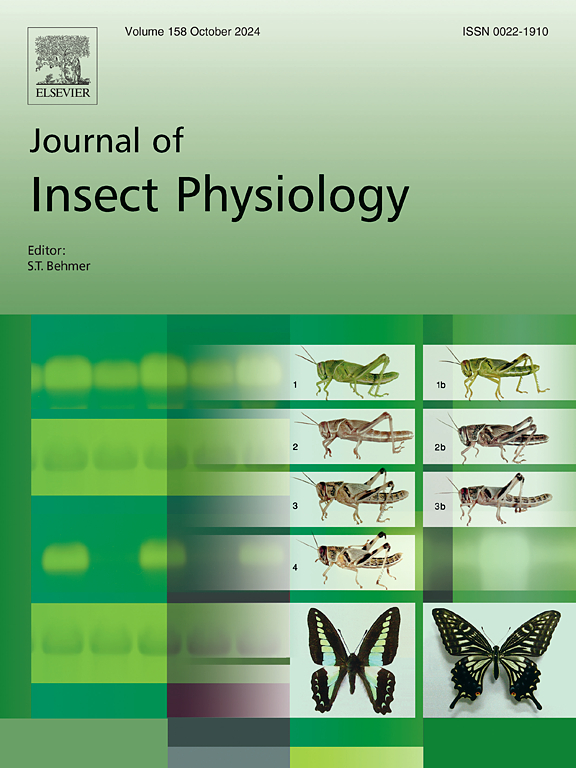Metabolization of the two most abundant polysaccharides, cellulose and chitin, by an extreme generalist insect, the American cockroach
IF 2.3
2区 农林科学
Q1 ENTOMOLOGY
引用次数: 0
Abstract
Cellulose and chitin are the two most abundant polysaccharides on Earth. To digest these structural carbohydrates, herbivorous and omnivorous insects typically rely on cellulases, while insectivorous species often express chitinases. The American cockroach (Periplaneta americana), an extreme generalist omnivore, is known to thrive on a variety of diets. However, little is known about its ability to metabolize structural polysaccharides such as cellulose and chitin. In this study, we fed cockroaches 13C-labeled cellulose and chitin to assess their metabolic capacity and the tissue-level allocation of these polysaccharides across sexes and life stages. Our results show that P. americana metabolized chitin at a significantly higher rate than cellulose and incorporated only chitin-derived carbon into body tissues, with clear sex- and life stage-specific patterns: nymphs allocated more chitin-derived carbon to their muscles, while females incorporated more into the fat body and reproductive tissues.
These results provide in vivo evidence of P. americana’s capacity to metabolize both cellulose and chitin but also reveal a strong preference for chitin utilization under carbohydrate-rich conditions. This study contributes to our understanding of nutrient allocation strategies in generalist insects and offers evolutionary insight into the digestive capabilities of Blattodea, shedding light on their adaptive strategies for utilizing a wide range of dietary materials.

代谢两种最丰富的多糖,纤维素和几丁质,由一种极端多面手昆虫,美洲蟑螂
纤维素和几丁质是地球上最丰富的两种多糖。为了消化这些结构性碳水化合物,草食性和杂食性昆虫通常依赖纤维素酶,而食虫性昆虫通常表达几丁质酶。美洲蟑螂(美洲大蠊)是一种极端的多面手杂食动物,以各种饮食而闻名。然而,对其代谢结构多糖(如纤维素和几丁质)的能力知之甚少。本研究用13c标记的纤维素和几丁质饲喂蟑螂,以评估它们的代谢能力以及这些多糖在不同性别和生命阶段的组织水平分配。我们的研究结果表明,美洲伪树代谢几丁质的速率明显高于纤维素,并且只将几丁质衍生的碳吸收到身体组织中,具有明显的性别和生命阶段特异性模式:仙女将更多的几丁质衍生的碳分配到肌肉中,而雌性则将更多的几丁质衍生的碳吸收到脂肪体和生殖组织中。这些结果为美洲拟南芥代谢纤维素和几丁质的能力提供了活体证据,同时也揭示了在富含碳水化合物的条件下对几丁质利用的强烈偏好。该研究有助于我们了解多面手昆虫的营养分配策略,并为舌目昆虫的消化能力提供进化视角,揭示其利用各种膳食材料的适应策略。
本文章由计算机程序翻译,如有差异,请以英文原文为准。
求助全文
约1分钟内获得全文
求助全文
来源期刊

Journal of insect physiology
生物-昆虫学
CiteScore
4.50
自引率
4.50%
发文量
77
审稿时长
57 days
期刊介绍:
All aspects of insect physiology are published in this journal which will also accept papers on the physiology of other arthropods, if the referees consider the work to be of general interest. The coverage includes endocrinology (in relation to moulting, reproduction and metabolism), pheromones, neurobiology (cellular, integrative and developmental), physiological pharmacology, nutrition (food selection, digestion and absorption), homeostasis, excretion, reproduction and behaviour. Papers covering functional genomics and molecular approaches to physiological problems will also be included. Communications on structure and applied entomology can be published if the subject matter has an explicit bearing on the physiology of arthropods. Review articles and novel method papers are also welcomed.
 求助内容:
求助内容: 应助结果提醒方式:
应助结果提醒方式:


